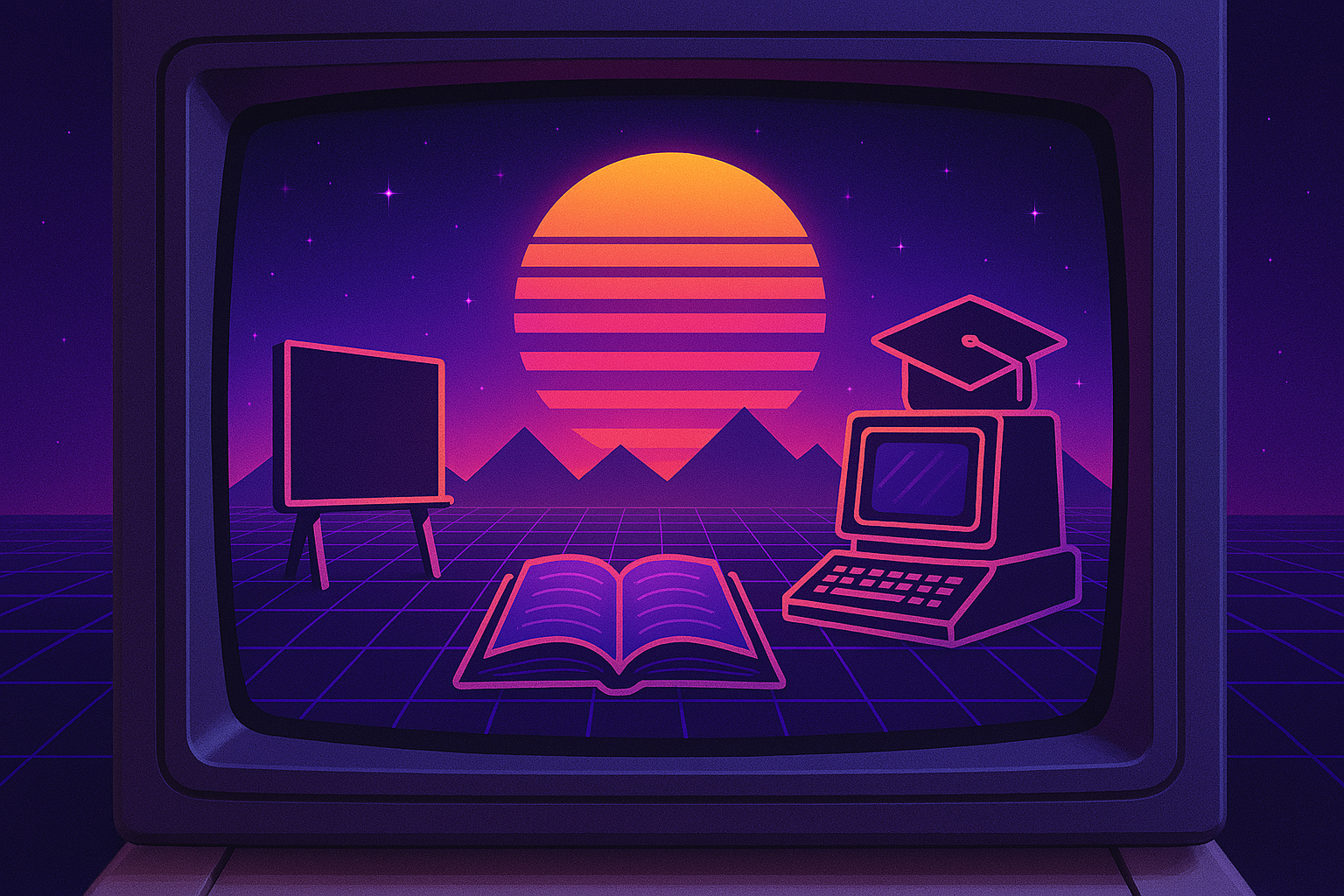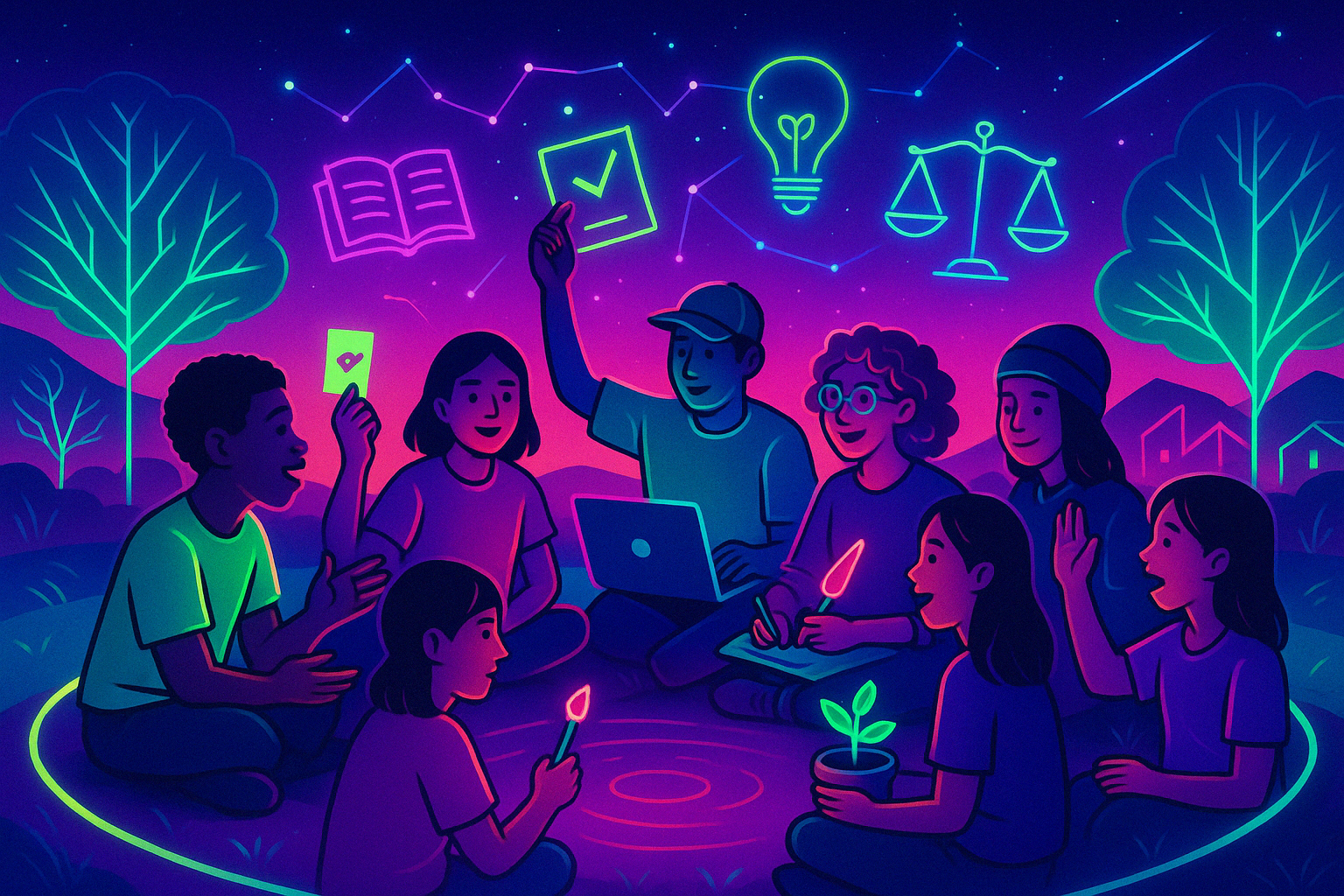
 John Moravec
John Moravec1.0 schools cannot teach 3.0, 4.0, 5.0 … kids
In one classroom, a student copies notes about a centuries-old war. Outside that school, they build game mods, edit videos for social media, and debate politics in global online forums. Another student learns formulas without knowing why, even as they help manage a family budget impacted by inflation, housing insecurity, and climate-related disruptions.
These vignettes show the widening disconnect between what happens in school and how students live and learn outside of it. While the classroom insists on obedience to a fixed curriculum, students navigate complex social and technological systems that demand adaptability, critical thinking, and creativity. As this gap grows, schools risk becoming disconnected from the realities that matter most to learners, undermining both relevance and purpose.
Education systems around the world remain tied to designs rooted in the 19th century. Schools still largely operate as they were originally intended in an industrial, “1.0” paradigm: to produce obedient workers and compliant citizens for industrial-era economies. Uniform schedules, teacher-centered instruction, and standardized assessments all reflect this legacy. While these structures once served a specific historical purpose, they are increasingly out of sync with the digital, interconnected, and rapidly evolving world we now inhabit.
Note. The 1.0, 2.0, and 3.0 labels draw from a framework presented in Knowmad Society (Moravec, 2013), describing the evolution of education systems. Education 1.0 mirrors the industrial model, focused on compliance and information delivery. Education 2.0 introduces some learner-centered approaches but remains teacher-directed. Education 3.0 marks a shift toward co-creation, networked learning, and participatory culture. As we accelerate toward 4.0 and 5.0 futures (marked by AI, ecological upheaval, and global interdependence) schools must evolve beyond passive transmitters of information and industrial skills development to become platforms for innovation, collaboration, and creativity.
These generational metaphors, introduced in Manifesto 25, represent how society evolves across technological and cultural waves. while most schools remain stuck in the old paradigm:
1.0 schools cannot teach 3.0, 4.0, 5.0 … kids. In other words, schools designed for the industrial age cannot meet the needs of a digital, interconnected era. We need to redefine and build a clear understanding of what we are educating for, why we do it, and for whom our educational systems serve. Mainstream compulsory schooling is based on an outdated, 19th-century model for creating citizens with the potential to become obedient factory workers and bureaucrats. In the post-industrial and increasingly digital era, this should no longer be the end goal of education. We need to support learners to become innovators, capable of leveraging their own imagination and creativity to realize new outcomes for society. We do this because today’s challenges cannot be solved through old thinking. And we are all co-responsible for creating futures with positive outcomes that benefit all people in the world.
Today’s learners, tomorrow’s challenges
Many of today’s students grow up in a hyperconnected world, shaped by digital ecosystems, participatory media, and instantaneous access to global knowledge. They form identities across multiple platforms, navigate overlapping cultures, and collaborate with peers in real-time across geographic boundaries. Their daily lives require adaptability, systems thinking, and creativity. They are expected to address complex global challenges (i.e., climate instability, political polarization, technological disruption) without the tools to make sense of a world that defies easy answers. While society demands that they be innovators, leaders, and problem-solvers, school often prepares them for roles and structures that no longer exist.
Yet the structure and culture of schooling remain tied to static curricula, rigid schedules, and assessment systems optimized for recall and routine rather than insight and invention. The gap between what students need and what schools provide continues to grow, exacerbated by technological acceleration and societal complexity. Classrooms often remain disconnected from the dynamic worlds students inhabit outside school, leaving many learners unchallenged, uninspired, or underserved. The cost is real: disengagement, lost potential, and a failure to prepare the next generation to lead meaningful change.
To move forward, we must rethink the purpose and structure of education. The goal can no longer be memorization and compliance. Instead, schools must attend to the development of imagination, critical thinking, ethical reasoning, collaboration, and the ability to generate novel solutions to emerging problems. Instead of treating students as passive recipients of knowledge, education must support them as active creators of knowledge and shapers of the future (Fullan, Quinn, & McEachen, 2018).
This transformation begins by asking two foundational questions: What are we educating for, and for whose benefit? Too often, education systems are not designed with learners in mind. They are shaped to serve the needs of labor markets, political institutions, and dominant cultural narratives. The school system was built to sort, control, and discipline—not to empower. It prepares students to fit into predefined roles, not to question or transform them.
Just smart enough to be obediently useful
As George Carlin (2005) brutally put it, the aim of education was to produce workers “just smart enough to run the machines,” but “just dumb enough to passively accept these increasingly shittier jobs.” His words captured a deliberate strategy to engineer compliance and suppress critical thought. The machines that once defined factory work have largely been replaced by algorithms, automation, and distributed systems. Yet the logic of control and efficiency still shapes how schools function today. And to who’s benefit?
This industrial model treats students as inputs in a production line: they are processed, measured, and outputted based on standardized benchmarks. Uniformity is rewarded. Deviation is penalized. Imagination is often considered disruptive. The result is an education system that suppresses curiosity in favor of order, and favors technical competency over ethical imagination. We may no longer train students to operate machines, but we continue to shape them to fit within the machinery of compliance. This is profoundly misaligned with the demands of our era.
For whom should education serve?
If we are honest about what we know today (i.e., about learners, about society, and about the scale of challenges we face) we must acknowledge that education systems built around standardization and sorting are no longer adequate. The goal cannot simply be employability or academic performance. We must educate for shared survival, democratic renewal, and collective capacity to shape equitable futures. Education determines whose voices are heard, whose knowledge is legitimized, and whose futures are made possible. To fulfill this role, it must equip all learners to make sense of uncertainty, act with ethical imagination, and engage fully in building a world marked by interdependence and flux.
The current model privileges dominant norms and ways of knowing while disregarding students whose languages, cultures, and lived experiences fall outside the mainstream. These exclusions are by design, inherited from systems built to enforce hierarchy and sameness. Reimagining education begins with naming this truth and committing to a different future. That future requires centering historically marginalized learners, educators, families, and communities as full partners in decision-making. Education must be a collaborative endeavor, not something imposed on students, but something imagined and built with them, grounded in agency, dignity, and shared ownership.
Reimagining school structures
If schools are to remain relevant, they must abandon the factory floor. In practice, this means reimagining how schools are organized and moving beyond outdated systems built for control and compliance. A 1.0 school model relies on standardization, siloed disciplines, bell schedules, and passive learning through lectures. These environments reward memorization, prioritize test scores, and structure learning in rigid blocks of time.
By contrast, schools built on 3.0 and beyond principles are learner-centered, adaptive, and networked. They support student agency through co-designed learning pathways and embrace learning that is interdisciplinary, relevant, and real-world. Instruction is organized around guiding questions and authentic challenges. Teachers serve as facilitators and co-learners rather than as sole authorities. Learners are invited to explore meaningful problems that require critical thinking, creativity, and collaboration across subject boundaries.
Time and space in these schools are flexible: students might collaborate across age groups, work on long-term projects, or connect with peers and mentors around the world. Classrooms are replaced with varying forms, perhaps as dynamic studios or community hubs, not rows of desks. Assessment shifts from standardized metrics to portfolios, exhibitions, and reflection. Success is defined not by right answers, but by depth of insight, growth over time, and the ability to communicate one’s learning in authentic ways.
In 3.0 schools, technology is not used to monitor or standardize learning. It helps students connect across cultures, access diverse knowledge, and express their ideas in creative ways. Technology becomes a tool for empowerment and exploration, not control. It helps students access global knowledge, build digital literacies, and design creative solutions. The curriculum includes emotional intelligence, systems thinking, media literacy, and critical reasoning. These are future-relevant skills essential for addressing emerging challenges and co-creating more just, sustainable outcomes.
Shifting from 1.0 to 3.0 and beyond must go beyond a surface-level reform, demanding a complete redesign of the space in which schools function, from how time is structured, to what is learned, to how learning is assessed. This new system must prioritize flexibility, collaboration, and relevance, supporting student agency and connection to real-world challenges. It should be built to prepare learners for a world defined by rapid change, uncertainty, and interdependence.
We cannot solve today’s problems with yesterday’s ideas and tools. The purpose of education needs to be redefined around the realities we face and the futures we need to build. This means confronting structural inertia and making systemic commitments (not symbolic gestures) to redesign schools that meet learners where they are. Instead of adapting students to fit outdated systems, we must adapt systems to support students’ development as informed, imaginative, and ethical change-makers. This requires a new focus on intentional redesign over replicating legacy models, which are already on life support in the broader socioeconomic reality.
The gap between yesterday’s schools and today’s realities is growing too wide to ignore. Bridging it means asking harder questions: Does this policy disrupt outdated systems or reinforce them? Does this educational design support imagination, collaboration, and relevance? Or does it support or compliance and control? If it keeps us tethered to the past, it must be rejected. To close the gap, education must become a space of open, creative design, not a confined factory, where learners are equipped to succeed in the future and to shape it on their own terms.
Read and sign Manifesto 25 at https://manifesto25.org
References and recommended readings
Anderson, J., & Winthrop, R. (2025). The disengaged teen: Helping kids learn better, feel better, and live better. Penguin Random House.
Carlin, G. (2005). Life is worth losing. https://georgecarlin.com/shop/life-worth-losing/
Fullan, M., Quinn, J., & McEachen, J. (2018). Deep learning: Engage the world change the world. Corwin and Ontario Principals’ Council.
Moravec, J. W. (Ed.) (2013). Knowmad Society. Minneapolis: Education Futures. https://educationfutures.com/publications/knowmad-society/
OECD. (2020). The future of education and skills 2030: OECD learning compass 2030. OECD Publishing. https://www.oecd.org/education/2030-project/



